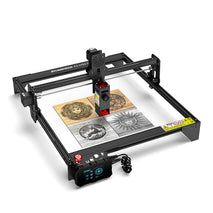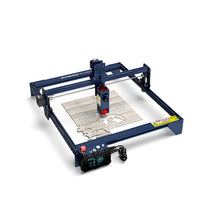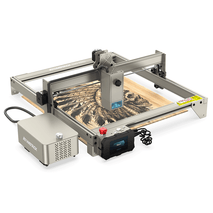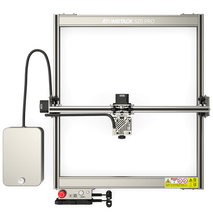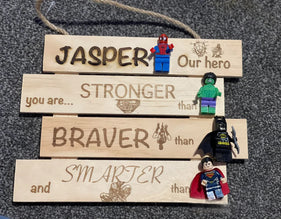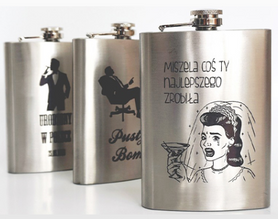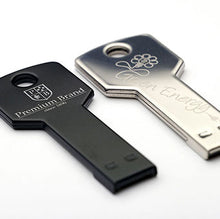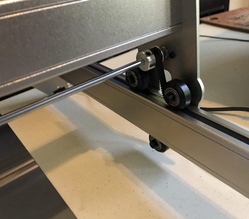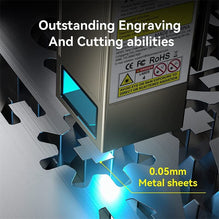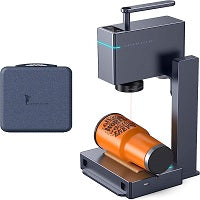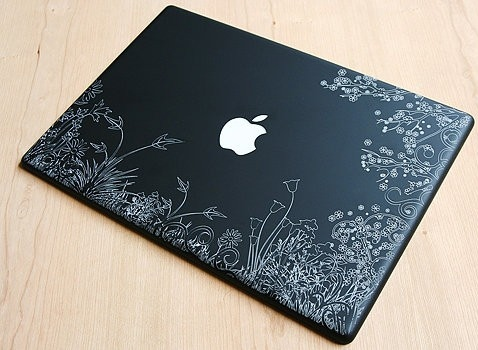
Should You Choose Laser Etching or Laser Engraving?
If you are relatively new to laser technology, you may be wondering what the difference is between laser engraving and laser etching. More importantly, which one is right for you.
The main difference between laser etching and laser engraving is that etching melts the microsurface to create raised marks, while engraving removes material to form darker marks. Both processes use high temperatures to create permanent marks on metal surfaces.
Both processes are heavily used for part traceability. Let's dig into each process and see which one is best for which application.
Laser Etching Process
When etching, the laser heats and distorts the microsurface of the material. By doing this, the laser-etched surface expands and creates texture.
Laser etching produces black and white marks and is the most effective process for permanently marking most types of materials. Etching is faster than engraving because it requires less energy from the laser beam.
You may need laser etching if:
Your part is made of any metal, except stainless steel
You want the fastest laser processing possible
You want a cost-effective laser that requires less laser power
You need to integrate laser marking prior to non-abrasive processing, including powder coating, e-coating and heat treatment
Laser engraving process
With the engraving method, a laser vaporizes a thin layer of material to create a tracking code. This is done by sending highly localized laser pulses to your part.
Instead of forming raised microsurfaces above the material, laser engraving penetrates deep into the material. Engraving depths up to 500 microns.
You may need laser engraving if:
Your parts are made of steel or aluminum
You want markers with maximum durability
You need to integrate laser marking before abrasive treatments, including shot peening and sandblasting.
Why do you need laser etching and laser engraving?
If you've tracked parts in the past using dot peening, inkjet printing, or printed labels, you know that these marking techniques require significant maintenance and consumable costs. Also, you may have to deal with inconsistent results due to an unreliable tagging system.
How Etching and Engraving Can Solve These Problems
Laser direct part marking encodes information that is inseparable from the product throughout its lifetime.
Laser marking is high resolution; a lot of information can be packed into a very small area, especially if you use Data Matrix codes.
Laser etching and laser engraving machines are very low maintenance.
Fiber and CO2 laser systems require no consumables.
Pulsed fiber lasers have very low power consumption.
Which industries use laser etching and engraving?
Many of our customers use laser etching and engraving to collect large amounts of information for their traceability programs. Some of them also use this information to optimize their manufacturing processes.
They use these laser processes to mark all types of barcodes, including QR codes and Data Matrix codes, as well as serial numbers and alphanumeric characters. Others also choose to have their company logo stamped on the part to brand their product.
The following are the most common industrial applications.
Automobile industry
Automakers have long required traceability from their suppliers. They were early adopters of Data Matrix codes as a means of uniquely identifying parts going into final assembly. Parts are scanned at critical steps throughout the value chain to ensure compliance and enhance accountability. Today, they require early part identification.
Learn more about laser marking for the automotive industry.
primary metal industry
Smelters, die-casting plants, hot- and cold-rolling plants, and extrusion machines came later, mainly because customers in the automotive industry demanded them. They found that data collected from internal traceability programs helped them optimize their processes. Other companies use laser marking to differentiate themselves from competitors by manufacturing products that meet stringent environmental standards.
Learn more about laser marking for the metal industry.
medical device manufacturer
The FDA has strict regulations requiring the labeling of medical devices. It requires most medical devices to be identified using a unique identifier.
More information can be found on the FDA's Unique Device Identification - UDI website.
Other industrial laser marking processes
Laser etching and laser engraving are not the only processes used in industrial applications. Laser annealing, although less common, is the only solution for marking stainless steel and chrome-plated workpieces.
The reason is simple: it is the only process that can produce a permanent mark while maintaining the natural corrosion resistance of the part.
Laser annealing heats the metal instead of engraving it. This process creates black marks beneath the surface through a reaction called oxidation.
The difference between annealing and etching is that annealing is a chemical reaction that does not melt the surface of the material. The difference appears subtle to the naked eye.
How to integrate laser marking machine?
Laser etchers and engravers need to be optimized for specific applications. Therefore, you should speak with a laser specialist to determine your needs. With HTPOWLASERS, you can choose a turnkey laser or marking laser and work with a system integrator to customize a solution.
The main difference between laser etching and laser engraving is that etching melts the microsurface to create raised marks, while engraving removes material to form darker marks. Both processes use high temperatures to create permanent marks on metal surfaces.
Both processes are heavily used for part traceability. Let's dig into each process and see which one is best for which application.
Laser Etching Process
When etching, the laser heats and distorts the microsurface of the material. By doing this, the laser-etched surface expands and creates texture.
Laser etching produces black and white marks and is the most effective process for permanently marking most types of materials. Etching is faster than engraving because it requires less energy from the laser beam.
You may need laser etching if:
Your part is made of any metal, except stainless steel
You want the fastest laser processing possible
You want a cost-effective laser that requires less laser power
You need to integrate laser marking prior to non-abrasive processing, including powder coating, e-coating and heat treatment
Laser engraving process
With the engraving method, a laser vaporizes a thin layer of material to create a tracking code. This is done by sending highly localized laser pulses to your part.
Instead of forming raised microsurfaces above the material, laser engraving penetrates deep into the material. Engraving depths up to 500 microns.
You may need laser engraving if:
Your parts are made of steel or aluminum
You want markers with maximum durability
You need to integrate laser marking before abrasive treatments, including shot peening and sandblasting.
Why do you need laser etching and laser engraving?
If you've tracked parts in the past using dot peening, inkjet printing, or printed labels, you know that these marking techniques require significant maintenance and consumable costs. Also, you may have to deal with inconsistent results due to an unreliable tagging system.
How Etching and Engraving Can Solve These Problems
Laser direct part marking encodes information that is inseparable from the product throughout its lifetime.
Laser marking is high resolution; a lot of information can be packed into a very small area, especially if you use Data Matrix codes.
Laser etching and laser engraving machines are very low maintenance.
Fiber and CO2 laser systems require no consumables.
Pulsed fiber lasers have very low power consumption.
Which industries use laser etching and engraving?
Many of our customers use laser etching and engraving to collect large amounts of information for their traceability programs. Some of them also use this information to optimize their manufacturing processes.
They use these laser processes to mark all types of barcodes, including QR codes and Data Matrix codes, as well as serial numbers and alphanumeric characters. Others also choose to have their company logo stamped on the part to brand their product.
The following are the most common industrial applications.
Automobile industry
Automakers have long required traceability from their suppliers. They were early adopters of Data Matrix codes as a means of uniquely identifying parts going into final assembly. Parts are scanned at critical steps throughout the value chain to ensure compliance and enhance accountability. Today, they require early part identification.
Learn more about laser marking for the automotive industry.
primary metal industry
Smelters, die-casting plants, hot- and cold-rolling plants, and extrusion machines came later, mainly because customers in the automotive industry demanded them. They found that data collected from internal traceability programs helped them optimize their processes. Other companies use laser marking to differentiate themselves from competitors by manufacturing products that meet stringent environmental standards.
Learn more about laser marking for the metal industry.
medical device manufacturer
The FDA has strict regulations requiring the labeling of medical devices. It requires most medical devices to be identified using a unique identifier.
More information can be found on the FDA's Unique Device Identification - UDI website.
Other industrial laser marking processes
Laser etching and laser engraving are not the only processes used in industrial applications. Laser annealing, although less common, is the only solution for marking stainless steel and chrome-plated workpieces.
The reason is simple: it is the only process that can produce a permanent mark while maintaining the natural corrosion resistance of the part.
Laser annealing heats the metal instead of engraving it. This process creates black marks beneath the surface through a reaction called oxidation.
The difference between annealing and etching is that annealing is a chemical reaction that does not melt the surface of the material. The difference appears subtle to the naked eye.
How to integrate laser marking machine?
Laser etchers and engravers need to be optimized for specific applications. Therefore, you should speak with a laser specialist to determine your needs. With HTPOWLASERS, you can choose a turnkey laser or marking laser and work with a system integrator to customize a solution.
Older Post
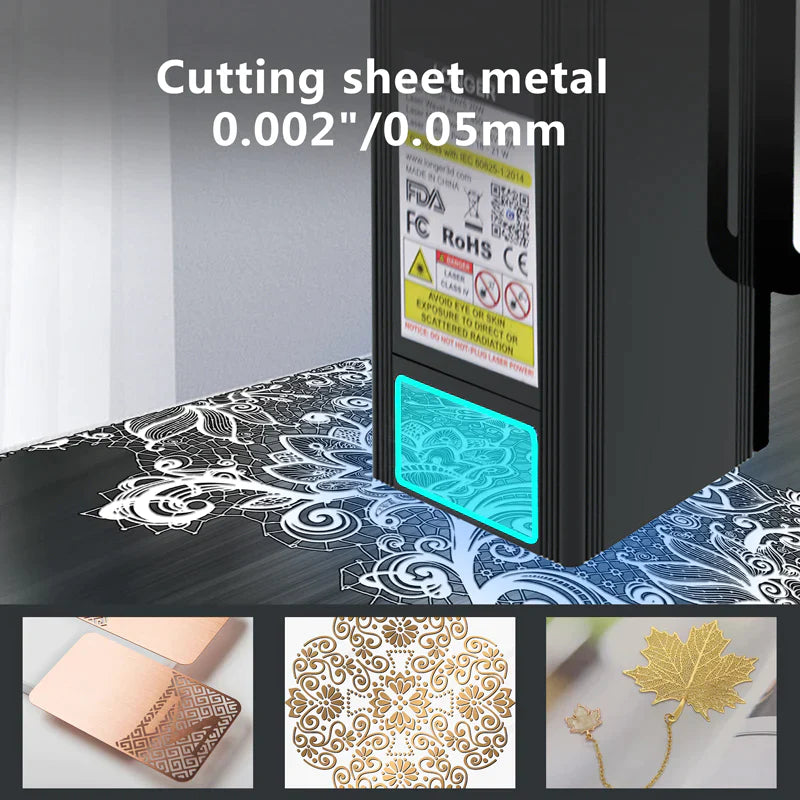
How Powerful Is A Longer 20W Laser Engraver?


